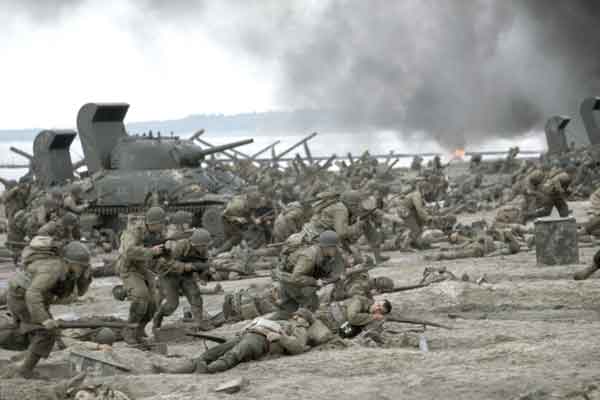
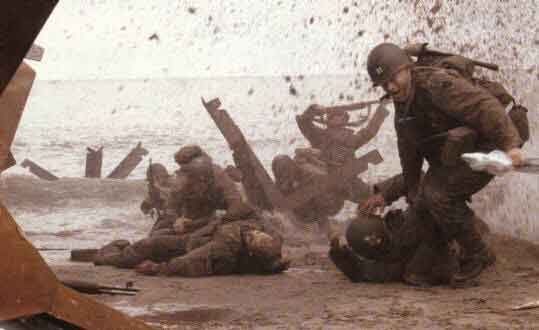
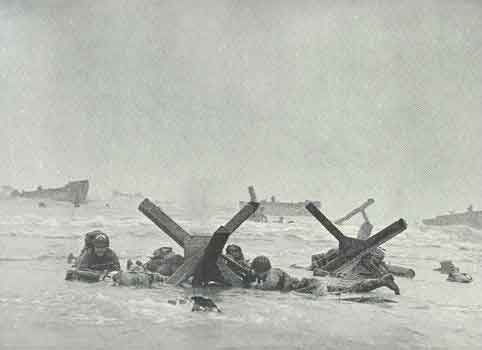
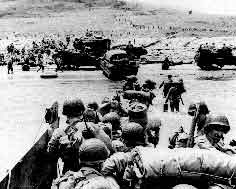
60 years later... D-day
This is a memorial page for all the brave men that gave their lives in fight for freedom of Europe on that glorious day of Tuesday, 6th of June 1944




"United in this determination and with unshakable faith in
the cause for which we fight, we will, with God's help,
go forward to our greatest victory."
– GENERAL DWIGHT D. EISENHOWER
In December 1943 U.S. President Roosevelt appointed General Dwight D. Eisenhower as supreme Allied Commander. His mission was to undertake operations with other allied nations to enter Europe, and defeat Germany and its armed forces. Originally this operation's codename was "Operation Roundup", but it later changed to "Operation Overlord". Enormous preparations were undertaken in Allied countries preparing for the mission of liberating Europe. Britain soon became a huge rally point for all invading forces, among which were: Americans, British, Canadians, Australians, New Zealanders, French, Belgians, Norwegians, Poles, Czechs, and Dutch. It was said to be the largest movement of soldiers in the history of mankind. They were all stationed in various cities, located mostly in the southern part of Britain. In early 1944 Britain had over 3, and a half million troops training, and preparing for the big operation. For already two years invasion of Europe has been preparing, and it was known as codename "Bolero". Americans moved almost all of their forces to Britain. 13,000 aircraft, along with 3,500 gliders awaited deployment. 12,000 war ships were preparing for this invasion as well. Ships were mostly stationed in Cardiff, and South Wales, from where some of those brave men took their last journey... German intelligence, and spies were a great deal of concern for the allied forces, so some of the towns stationing troops were completely closed for public, and operations inside were kept in total secrecy. At first Pas de Calais was considered a good landing spot for the invading troops, as that was the closest enemy point to the Allied forces, and it would give a very short supply line, but the Germans under command of Field Marshal Von Rundsteld came to the same conclusion, and constructed massive defense lines in Pas de Calais, therefore reinforcing the area. Massive reinforcing was placed on the so called Atlantic wall defenses in this area. The Atlantic wall was the pride of German Army, and Hitler used it for propaganda. It stretched from the north pole to the Perinea mountains. As Pas de Calais was such an obvious landing place, and already heavily reinforced, a new landing spot was chosen in Normandy. It was agreed that 5 landing beaches covering some 40 miles would be used for landings. Codenames for those beaches were: "Utah", "Omaha", "Gold", "Juno", and "Sword". 5 divisions landed in the first wave of attack, followed by 4 more divisions in the next 24 hours. The invasion was first planned for Monday June 5th. and first ships loaded with troops deployed from its naval bases on June 3rd. heading for their rendezvous points, but on June 4th there was a horrible storm so the invasion troops had to wait for favorable whether conditions in their rendezvous points for the next 24 hours. This weather had a bad effect on troops on board, and they suffered problems prior to the invasion. This was certainly not the ideal start of the invasion. The decision to attack was made by General Eisenhower, despite terrible weather, with the words - "Ok, let's go..."
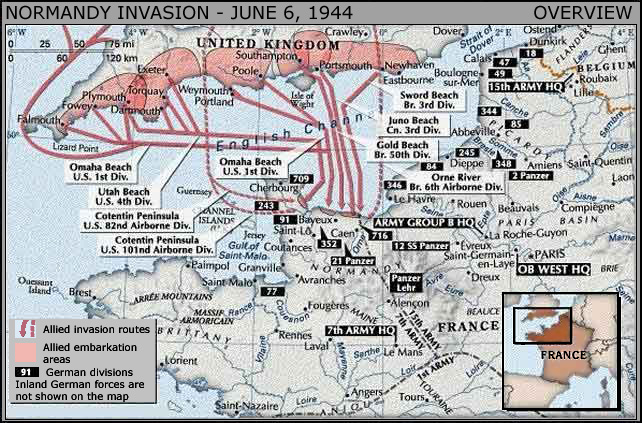
Invasion of Normandy started on the morning of Tuesday, 6th of June 1944. The Americans were divided by the river Vire estuary into two separate beaches. To the west of river Vire was located codename "Utah" beach, and to the east the codename "Omaha" beach. Americans 1st, and 29th Infantry Divisions from the U.S. 1st Army landed on "Omaha" beach, and the U.S. Army 4th Infantry Division landed on "Utah" beach. The British, and Canadians under the command of British 2nd Army landed east of Americans stretching all the way to river Orne estuary to the east. These beaches were codenamed, "Gold", "Juno", and "Sword". British 50th Infantry Division landed on "Gold" beach, and Canadian 3rd Infantry division under the command of the British Second Army, landed on "Juno" beach. British 3rd Infantry division landed on "Sword" beach. The British, and Canadians, easily overcame the light resistance of German forces, and so did the American troops at "Utah" beach, but U.S. 1st Division which landed on "Omaha" beach, confronted some of the strongest, and best German coastline forces, taking on heavy casualty from the 352nd German Division. In the morning it even looked as the attack on "Omaha" beach was going to fail, and Eisenhower was ready to call off the invasion. First wave of invading troops that landed on the beach did not manage to push through the heavy German defense lines, and fortifications equipped with heavy machine-guns. The first group of men to land at "Omaha" beach, company E suffered about 91 % of casualties. Next wave of assault was launched to reinforce U.S. troops. Germans responded to the Allied invasion by launching the 21st Panzer Division, into a gap between British 3rd, and Canadian 3rd division on "Sword", and "Juno" beaches, and their tanks almost reached the shore line. If the German tank division had succeeded in reaching the sea, the landings and invasion might have failed. The next few hours involved heavy resistance from the British antitank guns at Périers-sur-le-Dan, and have stopped the Germans from advancing to the sea. Canadian 3rd Infantry division was involved in heavy fighting at the city of Caen later that day. As they approached the town the German resistance stiffened, and the city was taken by the Allied forces only 9 weeks later. Before the invasion took place the British General Montgomery realized that both flanks to the west, and east would have to be secured for successful landings in Normandy. He deployed the British 6th. Airborne to the east flank, and U.S. 101st, and 82nd Airborne to the west. The droppings had to take place at night because the landings were scheduled for morning. Prior to the paratrooper's mission in Normandy started, General Eisenhower paid a visit to the paratroopers, with tears in his eyes wishing them good luck. For this mission to succeed full moon was required so that the paratroopers could see each other and have a better visibility at night, and so that the tide would be high there for the ships would be able to avoid the sea mines, and the landings could be easier, with less beach surface to cover for the Allied troops. The only time the moon, tides, and winds would be in the right phase was for three days starting with Monday, June 5th. In total 822 aircrafts, and gliders carrying paratroopers took off that night, and for some it was to be their last flight... The flights lasted about 2 hours. Paratroopers were taking on heavy antiaircraft fire, and prior to the jumping out of planes, clouds obscured visibility. Some of the U.S. 82nd Airborne, and U.S. 101st Airborne Division paratroopers which had to secure the flank to the west landed directly on "Utah" beach, but unfortunately many landed in the sea, which meant certain death, as they were loaded with heavy equipment, and they drowned... Some of them landed in a town called Sainte-Mère-Église, which saw some of the heaviest fighting. Sainte-Mère-Église was a strategic place where large German troops were stationed. Not a lot of soldiers from the 82nd Airborne Division attacked the town with the mission to take it, and there for secure safe landing on "Utah" beach. At first it looked like the operation was a complete disaster, but as the fighting continued, men from the 82nd Airborne Division liberated the town from the Germans with extraordinary determination and bravery. Field General Erwin Rommel was given the command over German Army group B in July 1943 which counted about 30 divisions, taking over defense of Belgium and northern France in December that year. Rommel too, considered Pas de Calais a likely landing spot for invasion of Europe, that he was expecting for a long time. He knew that when and where the invasion happens, the Allied forces would have to be stopped on the beaches, so he constructed obstacles all over Normandy coast line designed to stop any landing craft. The defenses were indeed successful. Tetrahedral obstacles were designed to float on water during a tide, with mines attached to them and many fine men died in their landing craft as a result of collision with obstacles, never reaching the shore... Rommel also knew that there had to be an air attack prior to the actual landings, so he had entire areas or Normandy flooded and turned into swamps. This was a successful tactic for him, as many Airborne troops loaded with heavy equipment landed unaware of the trap. He knew that the first 24 hours would be vital for both sides as he told his troops - "It will be the longest day". Prior to the landings Allied forces launched heavy bombing attacks on German defenses, but the aviation had little success in hitting the nazi defense positions, so to the surprise of the landing troops that only expected a minimal resistance, they were involved in one of the worst and bloodiest battles of the second world war.
Before the landings took place General Dwight D. Eisenhower gave a speech to his men.
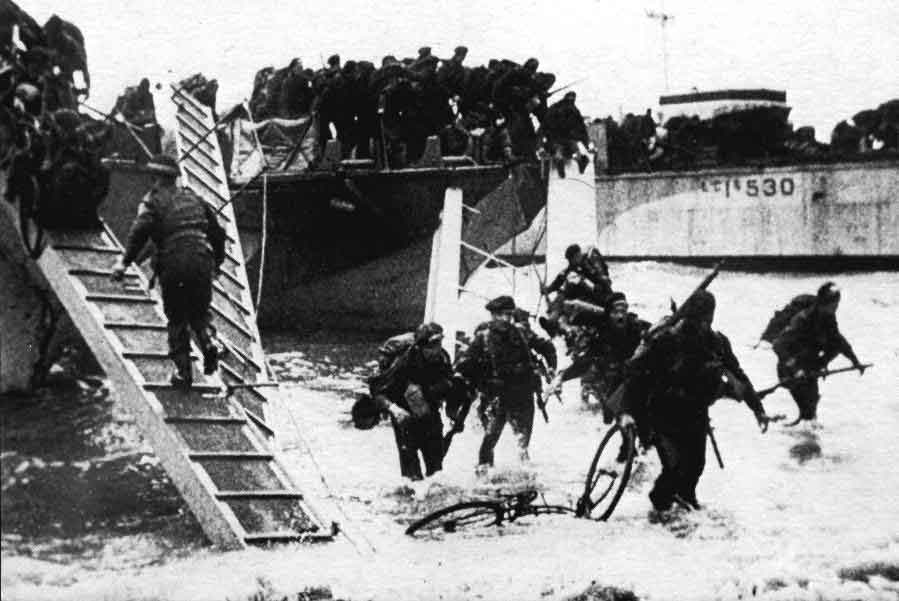
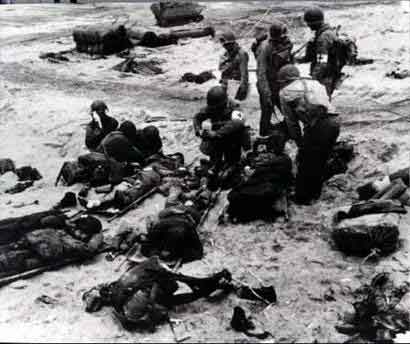
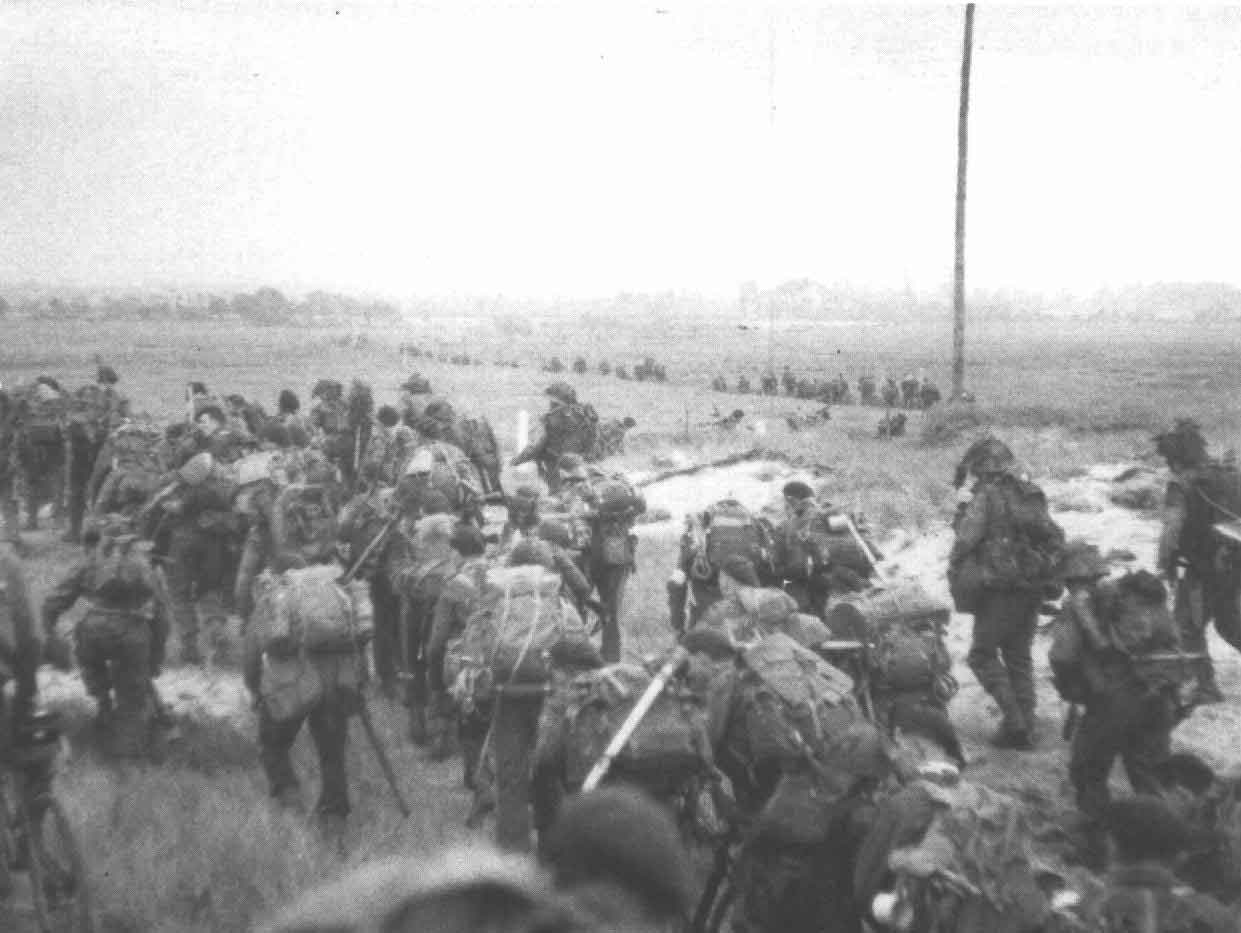
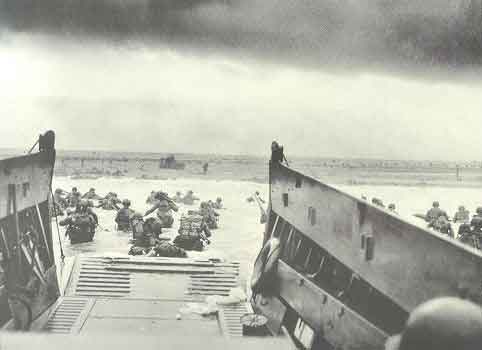
By 1:00 A.M. there were over 155,000 Allied troops waiting to attack the Axis Powers in Normandy. The attack consisted of 12,000 aircraft, 4,100 landing craft, 1,200 ships and 950 tanks. By 2:30 A.M. Allied troops were lowered to sea in their landing boats, heading for the beaches of Normandy. At 6:31 A.M. the Allies began their attack. A month before the troops were in the country of France, the Allies sent out 250 minesweeping ships to clear a path for the fleet of ships that were coming through. The American paratroopers were dropped in 50 square miles of Normandy. They were dropped behind the beaches so they could help take out the bridges. The Allies' plan was to first take out all bridges and roads leading to the beach so the enemies couldn't send reinforcements. When the Allies came to destroy the bridges, it went so easily and quickly that historians weren't sure who was more surprised, the Allies or the Axis Powers. Leigh-Mallory, an American general, assured General Walter Bedell Smith that the casualties would be around 50%. They were willing to loose that many soldiers because they knew it would have given the Allies a major advantage and help crush Hitler's resources, if they won. Hitler knew that the allies were going to attack, but he miscalculated and did not realize they were going to attack the five beaches that they did, much thanks to the Allied counterintelligence. D-Day was a bloody day for the Allies and the Axis Powers. German losses reached 240,000 killed or wounded, and 210,000 taken prisoner. The Allied price was also high with 17,700 killed, 13,500 missing, and 85,830 wounded.
After the battle General Eisenhower addressed the people of Europe with a short speech over the radio...
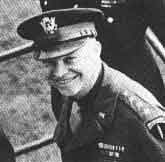
There are no words to describe the bravery, and the ultimate sacrifice these young men took, to liberate us from nazism and give us freedom, and liberation from oppression, terror and occupation... All I can say is... Thank you guys, you will never be forgotten!
Web site made by Igor Radisic from Belgrade, Serbia & Montenegro. E-mail: [email protected]
Bloody city... Stalingrad | Blue grave... Pearl Harbor | A bridge too far... Operation Marketgarden | Dust in the wind... El Alamein | Horrific thunder... Kursk
© Copyright protected. All rights reserved. Igor Radisic 2004 - 2005